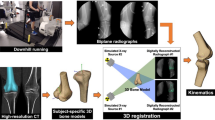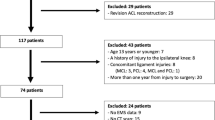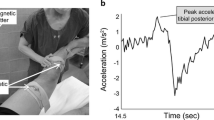Abstract
Purpose
Recent attention has been drawn to tibial plateau slope and depth with relation to both risk of anterior cruciate ligament (ACL) tear and kinematics in the cruciate-deficient knee. The purpose was to evaluate the relationship between native proximal tibial anatomy and knee kinematics in the anterior cruciate-deficient knee.
Methods
Twenty-two cadaveric knees underwent CT scanning to measure proximal tibia anatomy. Translation was measured during Lachman and mechanized pivot-shift tests on the intact knee and then after resection of the ACL. Pearson’s correlation was calculated to assess the relationship between tibial translation of the ACL-deficient knee and tibial plateau anatomic parameters.
Results
No significant correlation was found between ACL-deficient kinematic testing and tibial slope or depth (n.s.). Lateral compartment translation on Lachman and pivot-shift testing correlated with lateral compartment AP length (P = 0.007 and P = 0.033, respectively). The ratio of lateral AP length to medial AP length correlated with lateral compartment translation during the pivot shift (P = 0.002).
Conclusion
There was a poor correlation between native tibial slope and kinematic testing. There were, however, increases in translation during pivot-shift and Lachman testing with increased AP length of the lateral compartment. In addition, the finding of increased pivot-shift magnitude when the lateral compartment was relatively wide in the AP plane compared to the medial compartment suggests that patients with a “dominant” lateral compartment may be prone to a greater magnitude of instability after ACL injury.



Similar content being viewed by others
References
Alentorn-Geli E, Myer GD, Silvers HJ, Samitier G, Romero D, Lazaro-Haro C, Cugat R (2009) Prevention of non-contact anterior cruciate ligament injuries in soccer players. Part 1: mechanisms of injury and underlying risk factors. Knee Surg Sports Traumatol Arthrosc 17:705–729
Bedi A, Musahl V, Lane C, Citak M, Warren RF, Pearle AD (2010) Lateral compartment translation predicts the grade of pivot shift: a cadaveric and clinical analysis. Knee Surg Sports Traumatol Arthrosc 18:1269–1276
Bedi A, Musahl V, Steuber V, Kendoff D, Choi D, Allen AA, Pearle AD, Altchek DW (2011) Transtibial versus anteromedial portal reaming in anterior cruciate ligament reconstruction: an anatomic and biomechanical evaluation of surgical technique. Arthroscopy 27:380–390
Bowers AL, Spindler KP, McCarty EC, Arrigain S (2005) Height, weight, and BMI predict intra-articular injuries observed during ACL reconstruction: evaluation of 456 cases from a prospective ACL database. Clin J Sport Med 15:9–13
Brandon ML, Haynes PT, Bonamo JR, Flynn MI, Barrett GR, Sherman MF (2006) The association between posterior-inferior tibial slope and anterior cruciate ligament insufficiency. Arthroscopy 22:894–899
Citak M, Suero EM, Rozell JC, Bosscher MR, Kuestermeyer J, Pearle AD (2010) A mechanized and standardized pivot shifter: technical description and first evaluation. Knee Surg Sports Traumatol Arthrosc 19:707–711
Dejour H, Bonnin M (1994) Tibial translation after anterior cruciate ligament rupture. Two radiological tests compared. J Bone Joint Surg Br 76:745–749
Foster A, Butcher C, Turner PG (2005) Changes in arthroscopic findings in the anterior cruciate ligament deficient knee prior to reconstructive surgery. Knee 12:33–35
Frobell RB, Roos EM, Roos HP, Ranstam J, Lohmander LS (2010) A randomized trial of treatment for acute anterior cruciate ligament tears. N Engl J Med 363:331–342
Giffin JR, Stabile KJ, Zantop T, Vogrin TM, Woo SL, Harner CD (2007) Importance of tibial slope for stability of the posterior cruciate ligament deficient knee. Am J Sports Med 35:1443–1449
Giffin JR, Vogrin TM, Zantop T, Woo SL, Harner CD (2004) Effects of increasing tibial slope on the biomechanics of the knee. Am J Sports Med 32:376–382
Hashemi J, Chandrashekar N, Mansouri H, Gill B, Slauterbeck JR, Schutt RC Jr, Dabezies E, Beynnon BD (2010) Shallow medial tibial plateau and steep medial and lateral tibial slopes: new risk factors for anterior cruciate ligament injuries. Am J Sports Med 38:54–62
Hewett TE, Myer GD, Ford KR, Heidt RS Jr, Colosimo AJ, McLean SG, van den Bogert AJ, Paterno MV, Succop P (2005) Biomechanical measures of neuromuscular control and valgus loading of the knee predict anterior cruciate ligament injury risk in female athletes: a prospective study. Am J Sports Med 33:492–501
Hohmann E, Bryant A, Reaburn P, Tetsworth K (2010) Does posterior tibial slope influence knee functionality in the anterior cruciate ligament-deficient and anterior cruciate ligament-reconstructed knee? Arthroscopy 26:1496–1502
Irvine GB, Glasgow MM (1992) The natural history of the meniscus in anterior cruciate insufficiency. Arthroscopic analysis. J Bone Joint Surg Br 74:403–405
Keene GC, Bickerstaff D, Rae PJ, Paterson RS (1993) The natural history of meniscal tears in anterior cruciate ligament insufficiency. Am J Sports Med 21:672–679
Kennedy A, Coughlin DG, Metzger MF, Tang R, Pearle AD, Lotz JC, Feeley BT (2011) Biomechanical evaluation of pediatric anterior cruciate ligament reconstruction techniques. Am J Sports Med 39:964–971
Kocher MS, Steadman JR, Briggs KK, Sterett WI, Hawkins RJ (2004) Relationships between objective assessment of ligament stability and subjective assessment of symptoms and function after anterior cruciate ligament reconstruction. Am J Sports Med 32:629–634
Martineau PA, Fening SD, Miniaci A (2010) Anterior opening wedge high tibial osteotomy: the effect of increasing posterior tibial slope on ligament strain. Can J Surg 53:261–267
Meister K, Talley MC, Horodyski MB, Indelicato PA, Hartzel JS, Batts J (1998) Caudal slope of the tibia and its relationship to noncontact injuries to the ACL. Am J Knee Surg 11:217–219
Shelburne KB, Kim HJ, Sterett WI, Pandy MG (2011) Effect of posterior tibial slope on knee biomechanics during functional activity. J Orthop Res 29:223–231
Tayton E, Verma R, Higgins B, Gosal H (2009) A correlation of time with meniscal tears in anterior cruciate ligament deficiency: stratifying the risk of surgical delay. Knee Surg Sports Traumatol Arthrosc 17:30–34
Terauchi M, Hatayama K, Yanagisawa S, Saito K, Takagishi K (2011) Sagittal alignment of the knee and its relationship to noncontact anterior cruciate ligament injuries. Am J Sports Med 39:1090–1094
Yu B, Garrett WE (2007) Mechanisms of non-contact ACL injuries. Br J Sports Med 41(Suppl 1):i47–i51
Author information
Authors and Affiliations
Corresponding author
Rights and permissions
About this article
Cite this article
Galano, G.J., Suero, E.M., Citak, M. et al. Relationship of native tibial plateau anatomy with stability testing in the anterior cruciate ligament-deficient knee. Knee Surg Sports Traumatol Arthrosc 20, 2220–2224 (2012). https://doi.org/10.1007/s00167-011-1854-9
Received:
Accepted:
Published:
Issue Date:
DOI: https://doi.org/10.1007/s00167-011-1854-9




